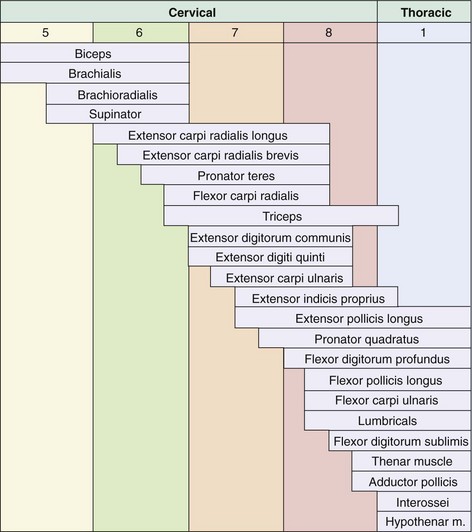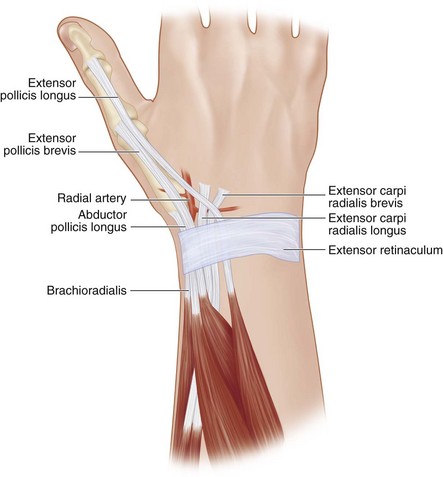Procedure 26 Reconstruction of Key Pinch in Tetraplegia Patients
Indications
 Procedure is used in patients with cervical spine injury with partial upper limb paralysis (spinal cord injury at or below C5 cervical segment) with at least grade 4 strength of the brachioradialis (BR).
Procedure is used in patients with cervical spine injury with partial upper limb paralysis (spinal cord injury at or below C5 cervical segment) with at least grade 4 strength of the brachioradialis (BR).
 Specific considerations for key pinch
Specific considerations for key pinch
Examination/Imaging
Clinical Examination
 Tetraplegia patients are classified based on the number of functional muscles with grade 4/5 Medical Research Council (MRC) strength below the elbow (Table 26-1). Based on what the patient has, the patient’s needs are matched by using a combination of tendon transfers, tenodesis, and arthrodesis to optimize surgical reconstruction.
Tetraplegia patients are classified based on the number of functional muscles with grade 4/5 Medical Research Council (MRC) strength below the elbow (Table 26-1). Based on what the patient has, the patient’s needs are matched by using a combination of tendon transfers, tenodesis, and arthrodesis to optimize surgical reconstruction.
 The purpose of the key pinch reconstruction is to allow the patient to produce a tenodesis effect to firmly pinch an object between the tip of the thumb and the radial border of the index finger. The differential excursion between the extrinsic flexor and extensor tendon system results in the tenodesis effect. When the wrist is extended, the flexor tendon becomes tight, resulting in finger flexion. With the wrist flexed, the fingers extend secondary to tightening of the extrinsic extensor tendons. Patients with tetraplegia use the tenodesis effect to help develop patterns of pinch function to assist in activities of daily living.
The purpose of the key pinch reconstruction is to allow the patient to produce a tenodesis effect to firmly pinch an object between the tip of the thumb and the radial border of the index finger. The differential excursion between the extrinsic flexor and extensor tendon system results in the tenodesis effect. When the wrist is extended, the flexor tendon becomes tight, resulting in finger flexion. With the wrist flexed, the fingers extend secondary to tightening of the extrinsic extensor tendons. Patients with tetraplegia use the tenodesis effect to help develop patterns of pinch function to assist in activities of daily living.
 It is important to assess the strength of the BR. Muscles chosen for transfer should be at least MRC grade 4 because they lose one grade after transfer. This is done by holding the patient’s elbow in midprone position and asking the patient to flex the elbow against resistance (Fig. 26-1). This will contract the BR. The examiner tries to move the contracted BR. If the BR cannot be moved easily with BR contraction, it is suitable for transfer. On the other hand, if the BR is flaccid and can move easily during contraction, the muscle may not be strong enough for transfer.
It is important to assess the strength of the BR. Muscles chosen for transfer should be at least MRC grade 4 because they lose one grade after transfer. This is done by holding the patient’s elbow in midprone position and asking the patient to flex the elbow against resistance (Fig. 26-1). This will contract the BR. The examiner tries to move the contracted BR. If the BR cannot be moved easily with BR contraction, it is suitable for transfer. On the other hand, if the BR is flaccid and can move easily during contraction, the muscle may not be strong enough for transfer.
 The index finger should also be assessed. If the index finger is flaccid, it may not provide a strong post for the thumb. The flexor digitorum superficialis (FDS) of the index finger can be sutured to the A1 pulley or the volar plate in a lasso procedure so that the index finger can be flexed to act as a post for the reconstructed thumb.
The index finger should also be assessed. If the index finger is flaccid, it may not provide a strong post for the thumb. The flexor digitorum superficialis (FDS) of the index finger can be sutured to the A1 pulley or the volar plate in a lasso procedure so that the index finger can be flexed to act as a post for the reconstructed thumb.
 The procedures required to achieve key pinch in group 1 and group 2 tetraplegia patients are as follows:
The procedures required to achieve key pinch in group 1 and group 2 tetraplegia patients are as follows:
Table 26-1 International Classification for Surgery of the Hand in Tetraplegia
| Motor Group | Functioning Muscles (Grade 4 or Greater) |
|---|---|
| 0 | No available muscles |
| 1 | BR |
| 2 | BR and ECRL |
| 3 | BR, ECRL, and ECRB |
| 4 | BR, ECRL, ECRB, and PT |
| 5 | BR, ECRL, ECRB, PT, and FCR |
| 6 | BR, ECRL, ECRB, PT, FCR, and finger extensors |
| 7 | BR, ECRL, ECRB, PT, FCR, finger and thumb extensors |
| 8 | Lacks only intrinsics |
BR, brachioradialis; ECRL, extensor carpi radialis longus; ECRB, extensor carpi radialis brevis; FCR, flexor carpi radialis; PT, pronator teres.









